
As an extension to the full 7 day Ireland itinerary, this is meant to be a comprehensive Ireland road trip travel guide that will help you with your own vacation planning.
When preparing for a big Ireland road trip, it helps to know from someone who’s been there. During our own trip around the country, we meticulously kept track of all the random bits of information that we learned along the way that we knew would be immensely helpful for any traveler planning their very own adventure.
Top Tips For Traveling To Ireland
Ireland Road Trip Travel Guide
We never expect to have a “flawless” trip and the intent of travel is never to be perfect because part of what makes travel so great is discovering and learning as you go. That being said, there are still things we wish we knew to help better prepare for the trip.
The following sections in the Ireland road trip travel guide are a breakdown of everything we learned that we know will allow you to travel smarter and be as prepared as you want to be.
Driving in Ireland

Having done Iceland just the year before, we felt pretty prepared coming into Ireland. However, we learned pretty quickly that things are quite literally the opposite and there are a bunch of factors you’re going to want to think about.
Driving in Ireland is personally the best way to truly see the country. It’s the only way that gives you the freedom to plan out an itinerary that meets your interests and timing. It’s also the only way to get you out to the picturesque country roads, to cruise along the dingle peninsula and slea head drive, or visit small towns on the edge of the Atlantic Ocean.
The left side
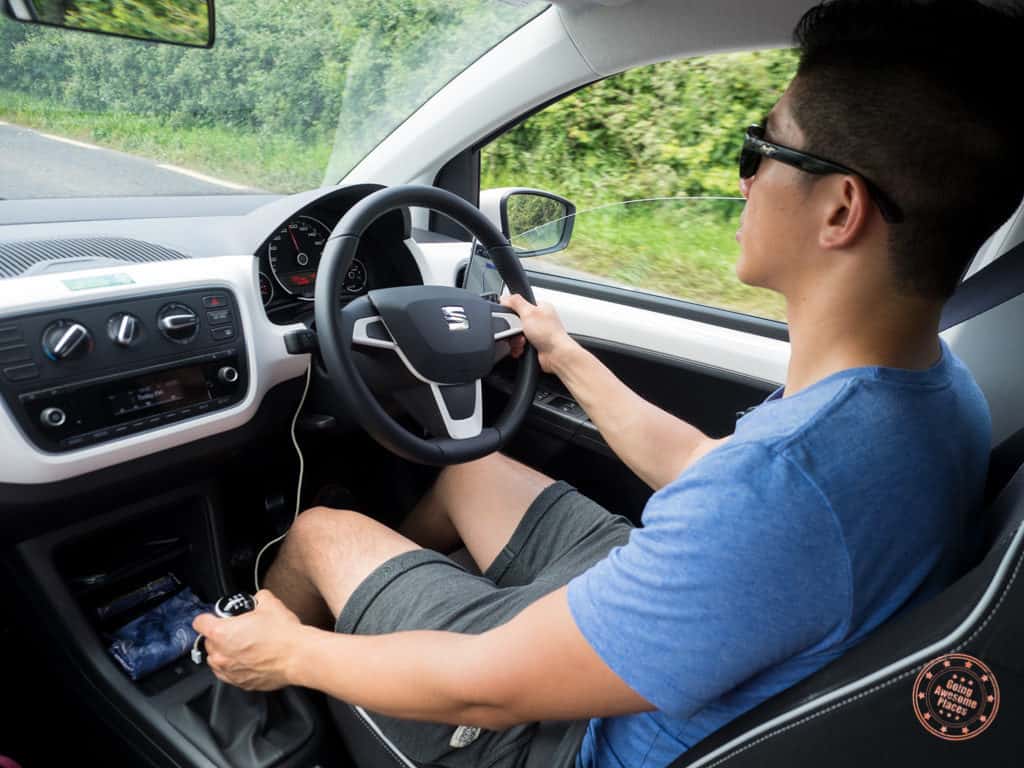
Perhaps the most obvious difference is the fact that Ireland drives on the left side of the road. If you’ve never done it before, this is going to be the biggest adjustment that you’ll have to stay conscious and almost vigilant about.
Driving on the left side of the road means everything is the opposite. To get yourself in the right frame of mind, and hopefully, we don’t overwhelm anyone here, here is what this means for you:
- The steering wheel is on the right side of the car
- If you get manual transmission car, you’ll be shifting with your left hand and not your right
- Left turns are easy (you only need to look right) and right turns are hard (make sure you’re clear on both sides)
- On the highway, the fast lane is on the right
Luckily, we’ve had some experience, but we’d be lying if we said we weren’t nervous that first day. The toughest part about being on the other side of the road is the instinct that your body should be towards the left line of your lane, when in fact you need to be closer to the right line.
A fun game you can play with yourself is that the white line on the right should be hitting the right edge of your car’s windshield.
Driving the roads
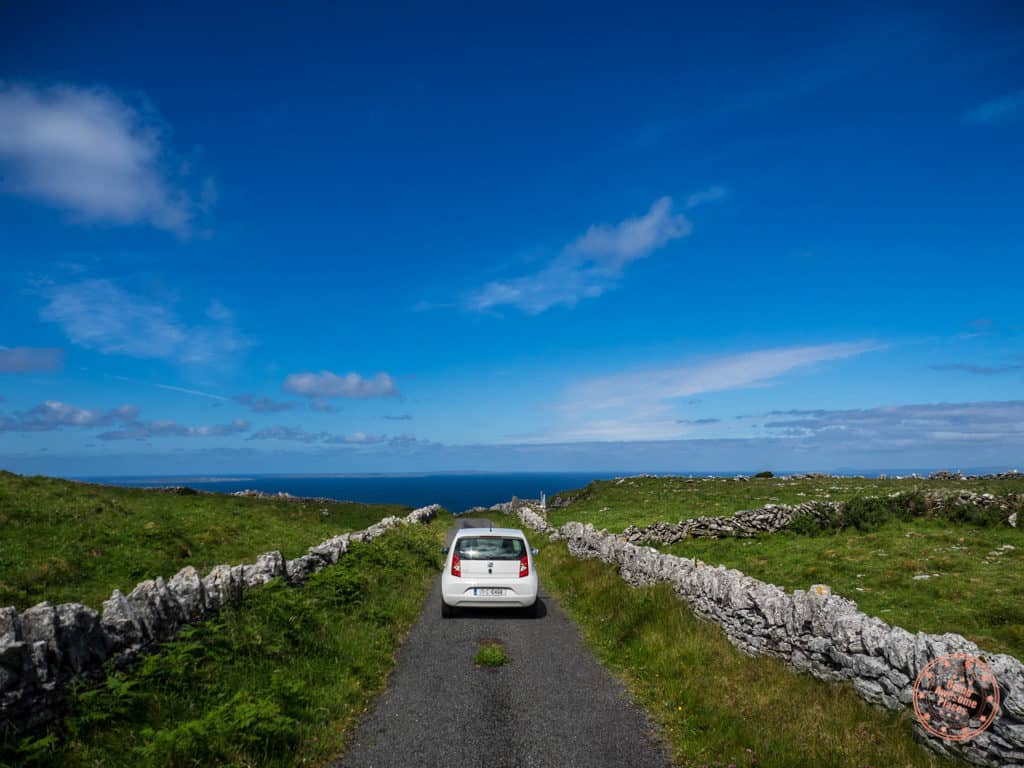
What fun you will have here. Driving in Ireland was perhaps some of the most challenging driving we’ve had to do while traveling. That being said, it isn’t as bad as some people say so don’t let them scare you!
Here’s what you have to pay attention to when driving around the country:
- Don’t expect too many highways – The highways are known as motorways (M-class) and there are only a few that branch out from Dublin and Belfast. For the most part, you’re going to be driving on R and L-class roads. These are all paved roads so no worries about needing to go off-road in Ireland.
- Narrow country roads – This was probably the biggest shock of all beyond driving on the left. There are plenty of roads you’ll be on that will be at most 1.5 car widths. When you’re the only one in sight this is fine, but our hearts may have skipped a beat each time there was an oncoming car. Locals drive really fast and the corners are particularly unpredictable, so we advise to be cautious tourists and take it slow. When you see a small oncoming car, slow down and squeeze a little closer to the left. If it’s a giant car/bus/truck up ahead, be proactive and tuck your car into the periodic make-shift shoulders to let them pass.
- The single lane roads – Around Dingle and some tiny country roads, the width will shrink down to one car width. Don’t panic! You just have to be careful about oncoming traffic. This is where those make-shift shoulders come into play. Pull off to allow someone on the other end to go through. Even if you can get a third of your car off to the side, that is often enough space. There will also be instances where you can’t pull off so be prepared to pull the car into reverse.
- Speed limits – For a majority of the non-M-class roads, the limits are set way higher than you really need to be driving. Jokingly, locals we talked to said that the real driving speed is half of what’s stated. Where you’ll feel this the most is around the peninsulas of the south (Ring of Kerry included) where giant coaches dominate the road.
- Roundabouts – If you’ve seen Mr. Bean, you’ll know the panic that sets in when you enter a roundabout. It’s unclear for people living in non-roundabout countries, like Canada, what the actual rules are. The foolproof way to perfectly execute a roundabout is to always be on the leftmost lane. When you’re about to enter, make sure the way is clear to the right. Once you enter, you’ll keep circling until you get to your exit. When you’re close, signal to the left to exit. You can use the second lane from the right to enter which gives you opportunities to leave on exits 2, 3, or 4, but it could get tricky depending on whether the left lane car is trying to do the same thing.
- Not many service stations – We remember making this comment while driving on the motorway. There are pit stops on the side of the road, but the bizarre thing is they’re only rest stations with a pullover area for parking. There are no bathroom facilities. The only real service station we encountered was during our drive from Galway to Dublin. That being said, Ireland is so small that you should be able to easily exit off of the motorway at any point to find a gas station or bathroom facility.
- Follow the suggested direction of driving – As much advice we heard about going against the flow of traffic for the Ring of Kerry, we personally wouldn’t advise it. Trust us, you really don’t want to be constantly jockeying for space on the road against coaches. Same goes near Giant’s causeway.
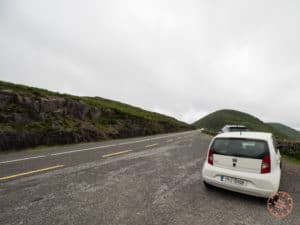
- Scenic pull overs – If there was one big thing we were annoyed with during our Ireland road trip, it’s the fact that there aren’t many scenic points with proper pullovers. It’s because the roads weren’t built to have extra width and the geology doesn’t often allow it. So we can’t complain really, but we did find ourselves wishing a number of times to be able to stop on the side to take a photo. It’s not like Iceland where the main highway has giant gravel shoulders on each side. Our tip for you is that if you see an area that looks like a safe place to stop, or is a proper scenic point, make the stop because the next one might not be for a while.
- Fold your side mirrors when parking in the city – We saw one car parked on the side of the road get hit by pass-through traffic. Don’t be that guy (either of them). Fold your mirrors if you can if you’re in a tight spot.
If you keep the above in mind, you’ll be fine driving out there.
Car rental companies
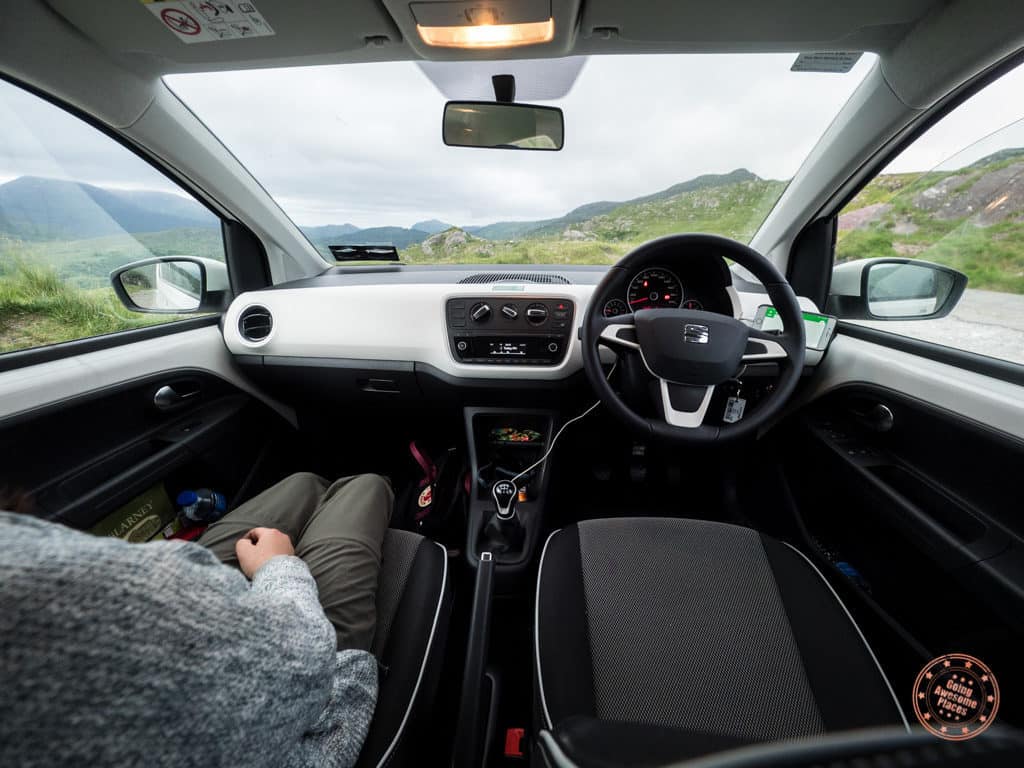
There are a lot of car rental companies. Initially, we were quite overwhelmed by all the choices. There are all the big chained brands but there are the smaller locally owned Irish ones as well. At the end of the day, after all of my research and quotes, it was Europcar that had the best deal. For 7 days, our rental only cost 56.18 EUR.
If Europcar doesn’t give you the best deals, don’t forget that there are a ton of car rental coupon codes that you can leverage before you visit Ireland.
If we had to distill everything we learned from our rental experience, follow these tidbits of wisdom as part of this Ireland road trip travel guide.
- Size matters – In Ireland, the smaller the better. With the tiny roads you want to have the tiniest footprint you can possibly have. For the two of us, the Seat Mi was perfect. There was just enough trunk space for two suitcases and the back row was for our quick access day things. Don’t get tempted by the offer of an upgrade to a larger vehicle!
- Transmission – To get the lowest prices, manual transmission is the way to go but if you don’t know how to drive stick, you’ll need to look for an automatic. Since most car rental companies have a limited number of automatic cars, they will naturally jack up the price significantly or run out quickly, so book as early as possible.
- Car insurance – This may be specific for Europcar, but everyone renting in Ireland should have this prepared. A friend of mine gave us the heads up that Europcar is extremely strict about renters who rely on their credit card as their primary insurance. As a result, it is mandatory to have a letter from your credit card company that has your card number and states the coverage that it has. If you don’t have it, they won’t let you proceed because it is mandatory to have coverage. In some ways, this is a ploy to force unsuspecting people to buy their insurance coverage, but it may be a country policy thing. For us, all we did was call American Express before our trip, explained the requirement for a letter by a car rental company, and they had one created for us within 15 minutes. It was emailed to me and all we had to do was print it.
- Air condition – We totally didn’t think about checking for this feature when we booked, but our little car didn’t have A/C. This makes sense in Ireland because 30C is extremely rare. Of course our first couple of days in Ireland it did hit those temperatures so we were craving A/C, but made do with the windows down. If this is a must for you, make sure you double check.
- GPS – We brought a standalone Garmin unit but with cellular data, it was actually better to use our phones with the Waze/Google Maps to account for traffic flow. This was preferable since we already had all our destinations pre-saved. Another thing to keep in mind in terms of GPS is that driving will often take longer than you think because the speed limits are so high and you’ll end up driving slower.
- Returning your car at Dublin Airport – We had quite the adventure trying to return our car. We probably should’ve read the fine line details but there is no clear signage as you drive into the terminal where you’re supposed to turn off. It is Parking Garage Unit C that you’re looking for which is tucked in behind.
- International driver’s license – No you don’t need one as long as you have your own license. Full details.
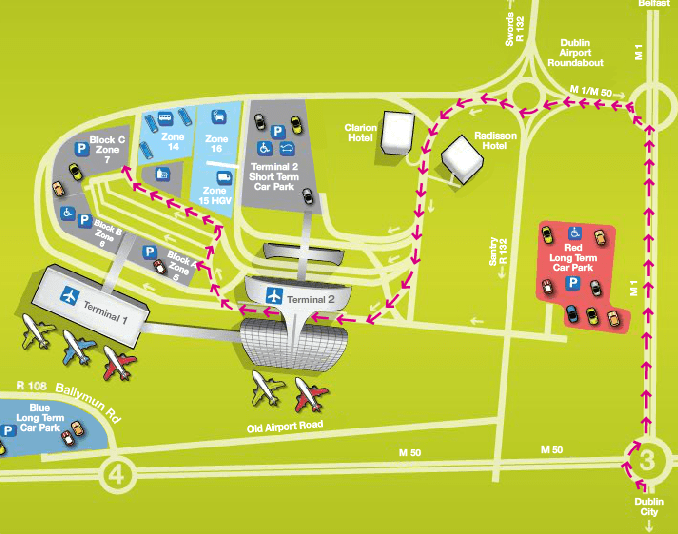
Filling up gas
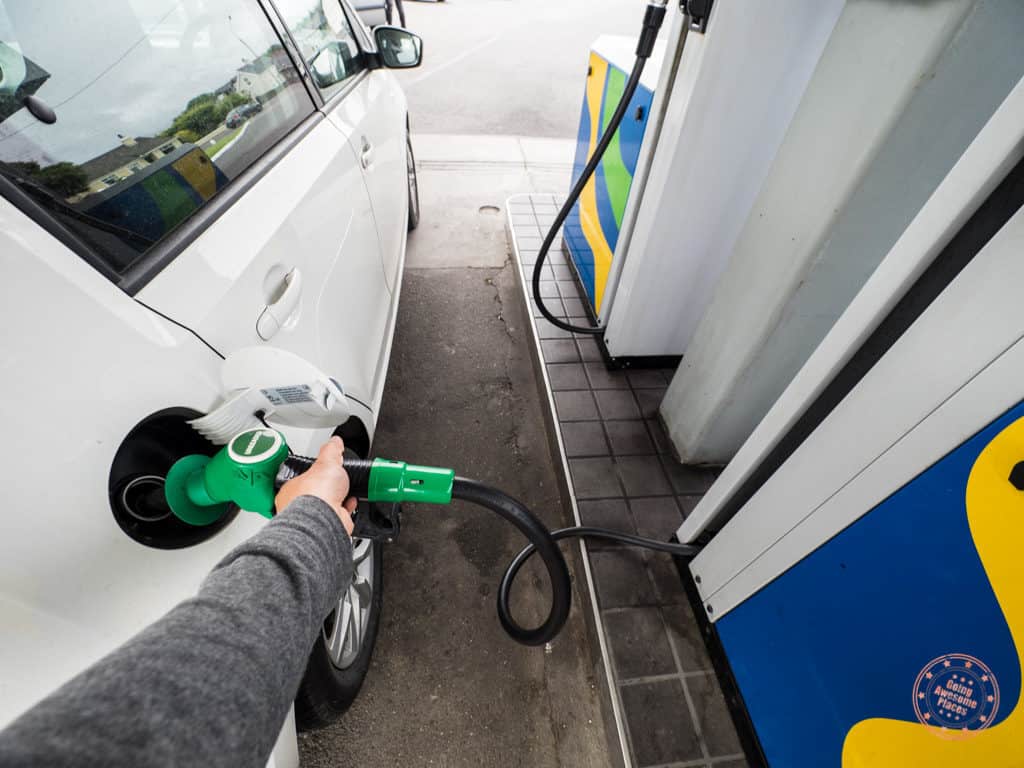

Unlike in our Iceland 8 day itinerary, this was super easy. Your choice at the pump is either green for gasoline or black for diesel. Make sure you get it right and use the indicator on the car (usually on the inside of the gas door or cap) to double check. There’s no octane to worry about.
You won’t be able to pay at the pump but it was always easy to walk inside to either pay by cash or credit card.
Cabs in Dublin
Driving in Dublin doesn’t make sense and as a result you’ll either need to return your car rental/pick it up later or park it at your hotel. To get around, you’ll end up taking a cab or there’s public transit too. In Dublin you are likely going to want to visit the Guinness storehouse for a pint, or visit the infamous Temple Bar so avoid driving after these trips!
We made an interesting observation when we were using cabs to get around the city. Uber and regular off the street cabs are the same thing. If you get a cab with Uber, the rate is set to “Meter” and you get a regular cab driver.
The problem we encountered with Uber was that we kept getting canceled. There’d be a car on its way and then it’d abruptly cancel to pick up someone off the street along the way. This got incredibly annoying.
In the end, we ended up trying both methods. Uber was good because there wasn’t the hassle of paying with cash and dealing with tips but if we wanted a cab right away, hailing on the street often was just more efficient.
If you’re looking for an enjoyable day in Dublin without any hassle at all of needing a cab, we recommend this Dublin city day tour, where you can explore what the city has to offer by bus. Or you can forget motor transportation all together and explore Dublin’s hidden gems on this walking tour.
Packing tips for your trip to Ireland
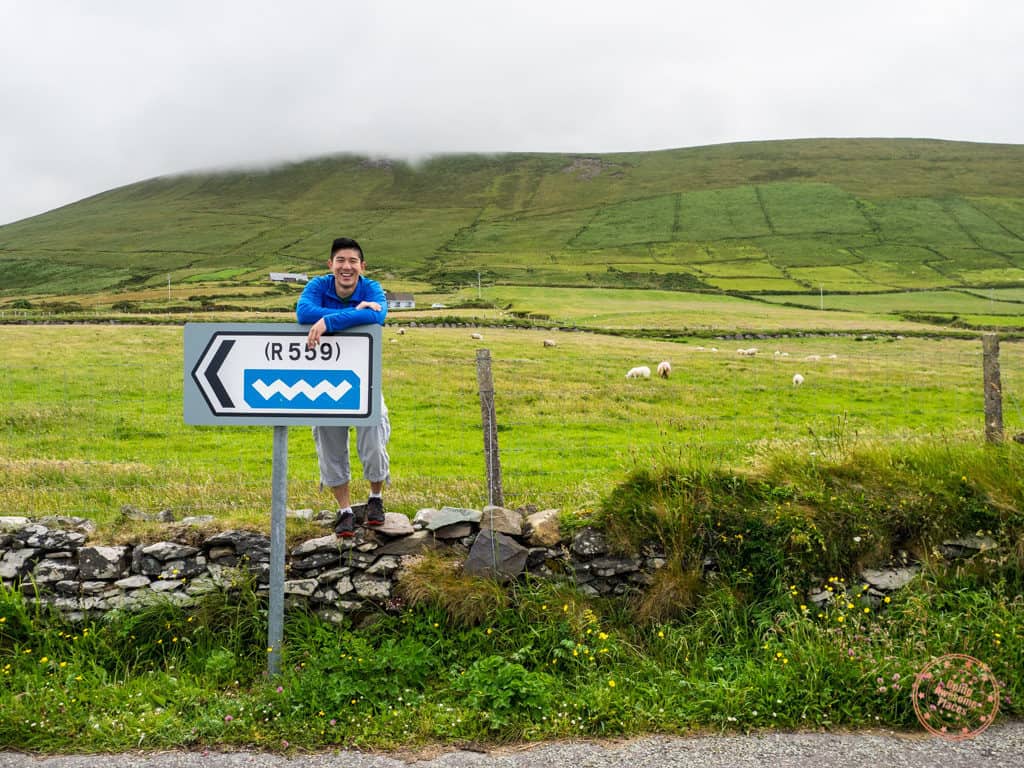
This being a road trip, the type of things you want to bring should bring to mind that you’ll have the luxury of having a car to store things as you go. Space should be less of a concern and the need to be ultralight. Power is also a luxury you have as you go.
As part of this Ireland road trip travel guide, here’s a list of the things we brought on the trip and why they should be on your packing list.
- Columbia Women’s Outdry Ex ECO Tech Jacket – Whether it’s this or another waterproof jacket, the key is to have a light and durable outer layer that will at least keep your upper body dry.
- Helly Hansen rain pants – We were lucky enough to never needs these on our trip but have learned from Iceland, it is always good to have pants that you can slip on.
- Columbia Conspiracy Titanium OutDry Trail Running Shoe – To round out the waterproofing gear, having good shoes that perform well during hikes, walks, and rain is so important. We love these shoes because they’re breathable, low profile which is good for summer, and very comfortable.
- Travel towel – B&B’s are great at providing amenities like towels, but the one instance for us where we needed this was at Galway Glamping. Whether you need it or not, these are super compact and can be useful in other scenarios like if you get wet from the rain, decide to go to the beach, or do surfing lessons.
- Eagle Creek Pack-It Specter Cube Set – These are awesome for any travel you do. We’ve been using this set for awhile to keep our shirts organized, underwear together, and all our random loose cables and chargers in one spot.
- Victorinox Travel Organizer – Ireland was so safe that we didn’t feel the need to travel with a money belt so organizers like this were perfect to keep my passport and travel papers nice and tidy.
- Toiletry kit – The hanging toiletry organizer is a must for any traveler. We’re a big fan because the hook allows you to hang this off of a vanity mirror or towel rack in a hotel/hostel and gives you counter space. Kits like this are small but surprisingly allow you to pack a ton of things inside.
- Travel power bar – Surge protectors such as this that take 1 outlet into 3 is helpful especially if you have to charge a bunch of things at night. You never know how many outlets your B&B or hotel is going to have so this is super handy.
- Cigarette USB adapter – USB plugs in cars are notorious for being slow charging. Get one of these chargers for the cigarette adapter to allow two USB devices to be charged at the same time and at a faster rate. The one we used was unfortunately a slow speed one.
- Power bank – If you have more devices you want to charge on the go and you’ve run out of ports/adapters in the car, it’ll be smart to have a basic power bank as your back up. This Xiaomi one has a ton of capacity (10,000 mAH) and is super light.
- Car phone holder – If you’re going to be using your phone as your GPS, don’t forget to bring a holder. Our favorite are these magnetic ones which clip to an air vent. The unfortunate thing for us was that we didn’t account for our rental car to not have a regular air vent which made it near impossible to mount. We eventually found a way but it was at a weird angle and the phone would periodically fall off. The kind of things you don’t really think about when you’re packing right?

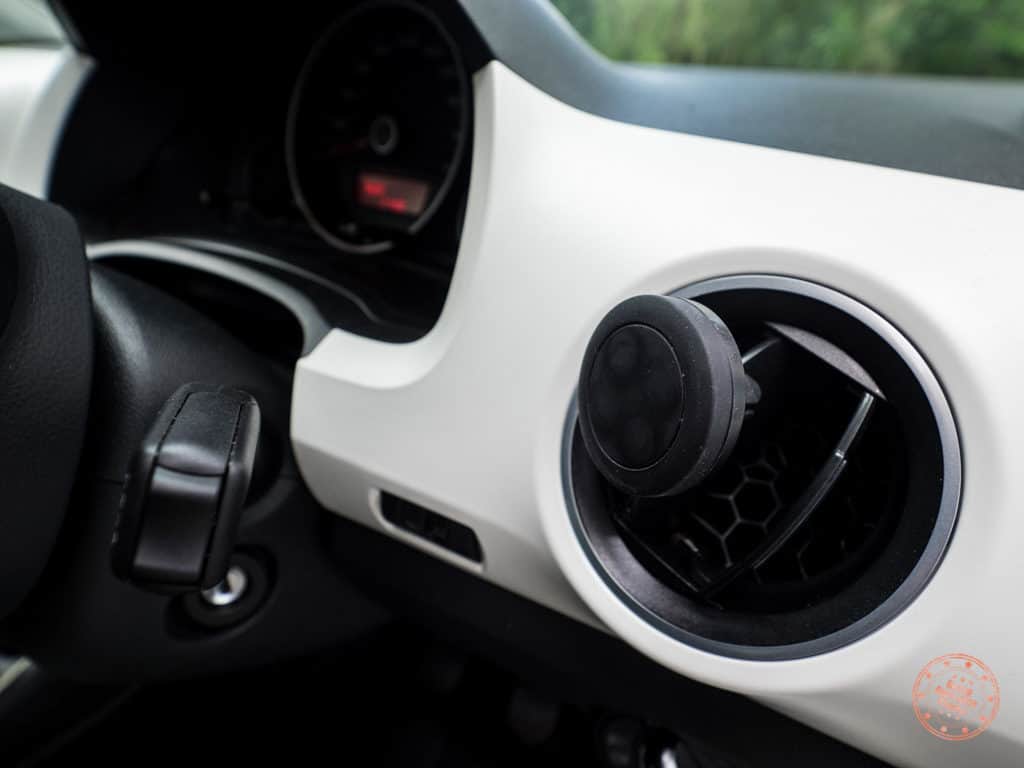
Costs
This tally of costs gives you a bit of insight into our spending from 7 days in Ireland. It’s meant to be a guideline to help you budget how much you’ll need. We’ve broken things down by high level categories.
For simplicity, we’ve converted everything to CAD. Also keep in mind that these are for 2 travelers.
- Air – $1,908.24
- Accommodation – $1,078.61
- Activities and Excursions – $386.01
- Auto Expenses – $223.04
- Car Rental – $83.40
- Food – $519.98
- Souvenirs – $88.47
TOTAL = $4,287.75 ($2,143.88 per person)
From this, you’ll see that a big part of the expenses for our trip were the flights. Ticket prices are constantly fluctuating but if you’re able to grab a flight at a good price, your expenses would drop considerably.
Other ways to keep costs low would be on food and accommodations. We’d say that for us, while we cut lunch on most days, dinner ended up being quite expensive. If you’re more careful, you can keep spending on food low. Accommodation wise, there’s always ways to find cheaper accommodations but you get what you pay for. The B&Bs and hotels we stayed at were very good for the price and we’d recommend each and every one of them.
To tip or not to tip
There is not a strong tipping culture in Ireland but many locals and visitors do tip for services. Use 10% as your rough guideline.
Remember tax-free
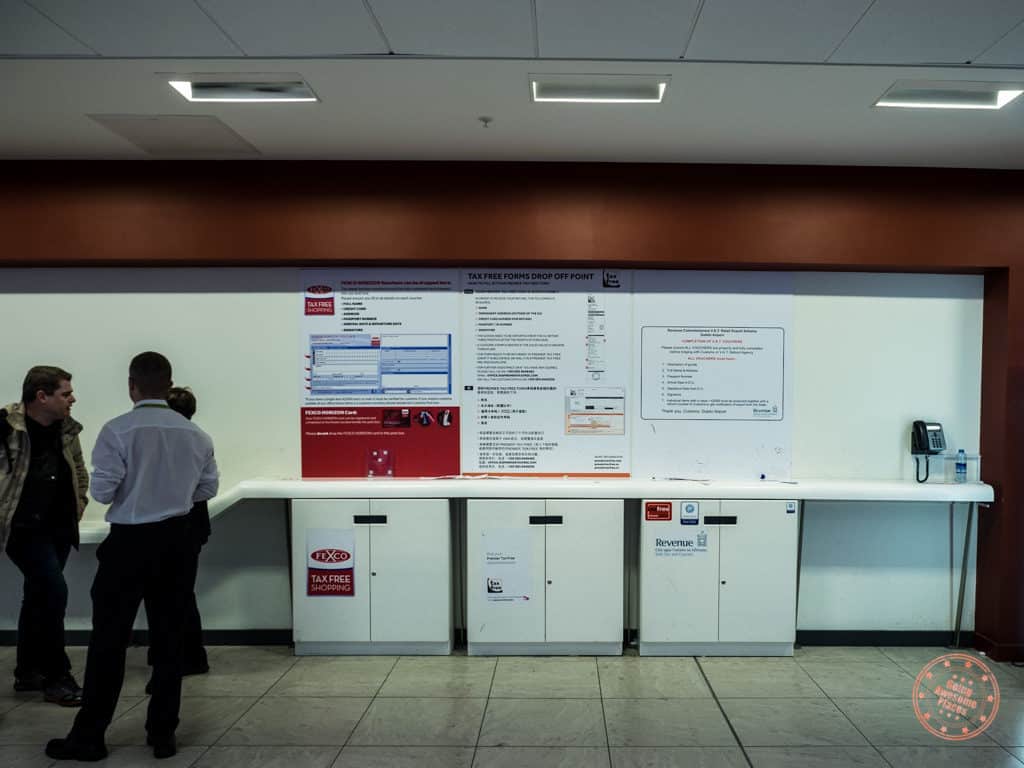
Whenever you make any sort of purchase at a large store, such as Blarney Woollen Mills as we did, ask for a tax free receipt. They’ll print out a special receipt and provide you with an envelope.
If you fly out from Dublin, once you pass through security, there will be a wall where you’ll see some signage for tax-free. This is an unmanned booth. The expectation is for you to fill out the necessary details in the form (most likely built into the receipt), put this into the provided envelope and drop it into the slot. Note that there are several companies that offer tax-free. Put your envelope in the right one and hope for the best!
Photography and videography
The photography opportunities in Ireland are just brilliant and the same thing goes for video. The natural beauty combined with the legendary medieval and going even further back, prehistoric history is unparalleled.
Lighting conditions
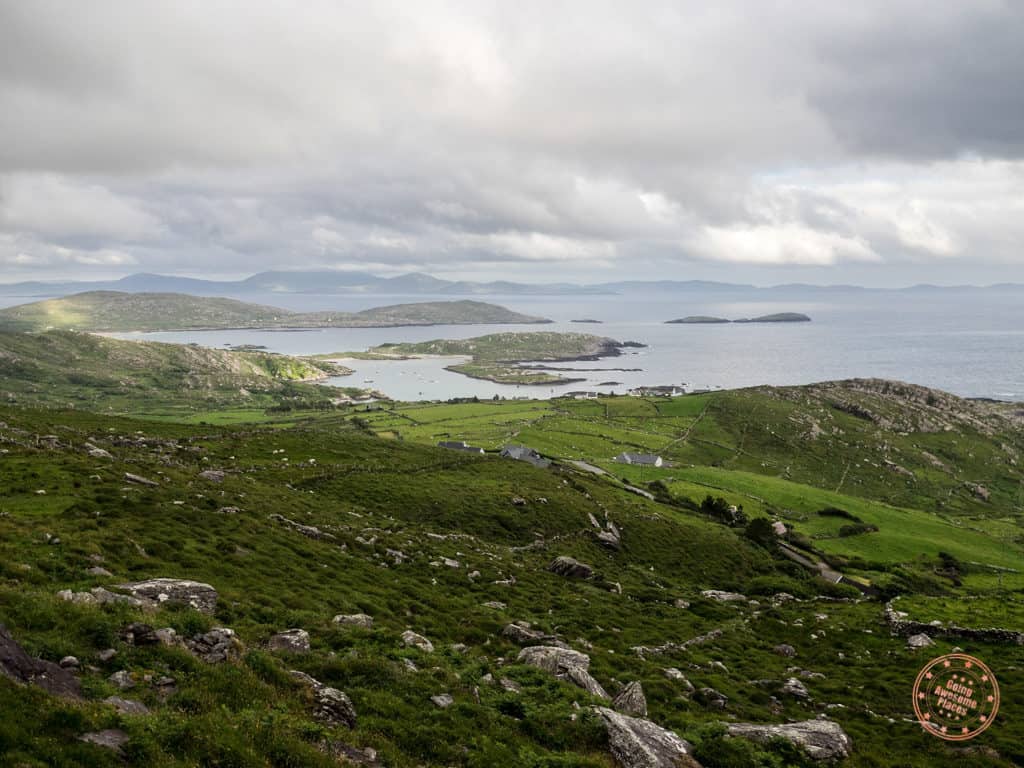
Ireland’s weather consists of a lot of rain, but even when the forecast says rain, it’s often not a continuous rolling rain. It comes and goes.
On average, we’d say there’s a lot of overcast skies and that could be good or bad depending on what you’re looking to shoot. For the wide landscape shots, they unfortunately make your skies look very dull. However, if you’re shooting people or architecture, it’s actually a good thing because you don’t often get overblown highlights.
The most challenging shooting situation
For this trip, it was when we were at the Cliffs of Moher right in the middle of the day. The sun was beating down from the top and, because of the contour of the cliffs, it naturally created a lot of shadows. To overcome this, we luckily had our gradient drop in filter to balance out the overwhelmingly bright sky and water with the very dark rock that needed to be boosted. We tried HDR as well to help but we didn’t like the effect it created.
It definitely wasn’t the ideal time to be there but you have to make lemonade right?
The best timing
It’s no surprise that sunrise and sunset are still going to be your best times for capturing photos. It’s during the golden hour when you get the vivid hues in the cloud and you don’t have to worry about harsh light so you can have a well balanced photo.
The tough part with an Ireland road trip is that you’re under the gun to hit spots at certain times in order to not fall behind. That means you’re not going to be able to visit every destination at sunrise or sunset.
For this Ireland road trip travel guide, what we recommend is that if there is a specific shot you just have to get, plan around it. The rest, let it just happen the way it was intended to.
Getting ideas
Besides the photos that you’ll find on the blog here, one way we quickly scout out a new place before the trip is to search Flickr to see what others have been able to capture. Just type in the city, county, or specific sight and you’ll be able to get all sorts of good ideas.
Our camera kit
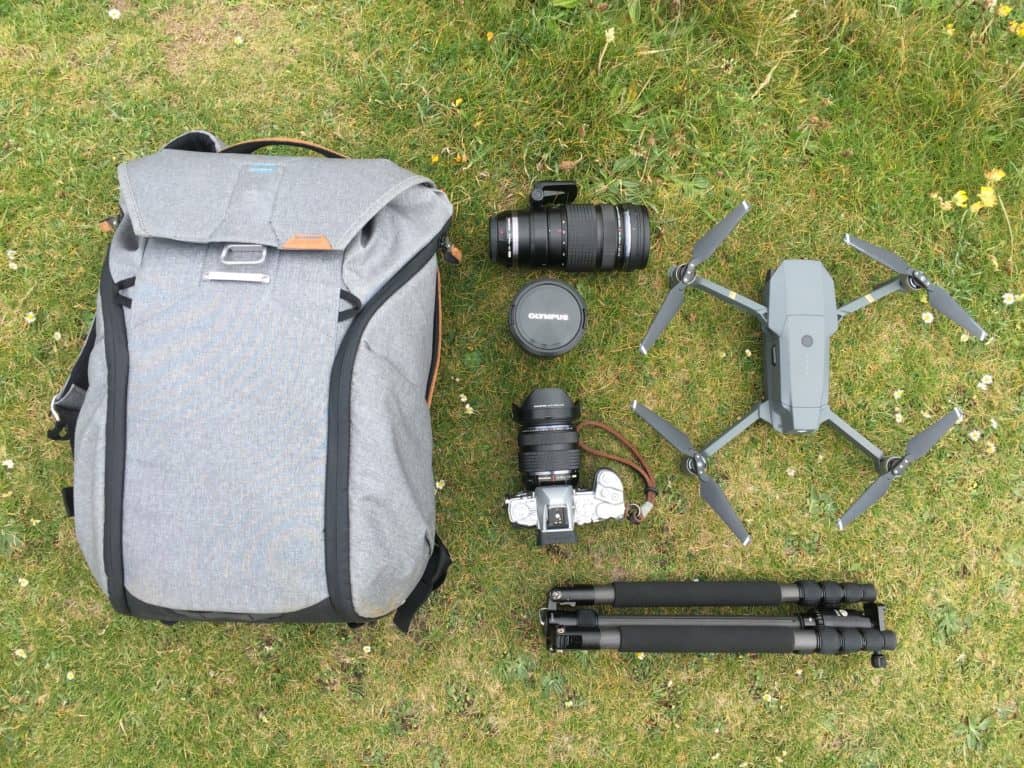
As you know we’re big fans of the micro four-thirds mirrorless system by Olympus, so this is going to be heavily biased, but this gives you an idea of how we pack our camera gear.
- Backpack – The 30L Peak Design Everyday Backpack is our go-to travel daypack/camera backpack. Make sure you read and watch my review.
- Body (Olympus OM-D E-M1) – We’ve since upgraded to the OM System OM-1 but this is a stalwart of a camera that is packed with so many features but a fraction of the weight of our full frame Canon gear. Read more on why I’m a big fan of M43.
- Lenses (Olympus M. Zuiko 12-40 f/2.8, 7-14 f/2.8, and 40-150 f/2.8 PRO lenses).
- Filters – UV filters on all the lenses and a circular polarizer on the 12-40 lens. For drop-in filters, we’re currently using the Formatt Hitech 100m holder paired with the adapter for the 7-14mm lens and graduated ND filter kit.
- Cleaning – Always helpful to have a simple microfibre cloth, Lenspen, and blower because you’re going to encounter, rain, dust, and fingerprints.
- Tripod – We bring a super lightweight tripod for travel. We don’t use it all the time but they do come in handy for things like long exposure shots, sunsets, and cinemographs.
- Drone – Mavic Pro with ND lens filter set for aerial shots.
- GoPro – GoPro Hero 5 with stick for handheld video.
The drone situation
Flying drones is still largely unchartered space but more and more, increased flight limitations are being put in place both by the government and special locations. As we drove around the southern part of Ireland, we encountered a number of sights where there were very visible “no drone” symbols near the entrance.
Then there were many locations that weren’t marked. With DJI, several locations were marked as either strict or warning no fly zones (NFZ). In the strict case, my remote actually made me acknowledge we had rights to fly there. We couldn’t resume flying otherwise. In the warning case, there was an NFZ statement that would pop up on the side but could be ignored.
As a precaution, we did register my drone with the IAA (Ireland Aviation Authority) on their drone registration page. We didn’t really know how this would help but we thought it couldn’t hurt.
For us, in the cases where there were clear no fly markings, we’d adhere to it in the direct area but was a bit more liberal about flying the drone outside of it. For instance, we knew drones weren’t allowed to be flied overtop the Rock of Cashel but we drove to a nearby farm which allowed us to fly it around its perimeter. In areas where we didn’t see (possibly missed) markings, we flew where we could. Typically this still meant trying to launch away from a crowd and hidden somewhere so that we could do a quick fly by at high altitude as quickly as we could before flying back home. The key is to be as discreet as possible.
We adjusted our altitude to be 200m and at the upper end, noise was at a minimal but we’d say even at 150m, it was quite noticeable.
We’re no authority on drone flying and the rules are still quite fuzzy, but at the end of the day it’s about being smart about flying and not disturbing people while you fly.
Map Of Ireland
Below is a map of all the counties in southern Ireland, and don’t forget Northern Ireland is kinda another place entirely and is part of the UK.
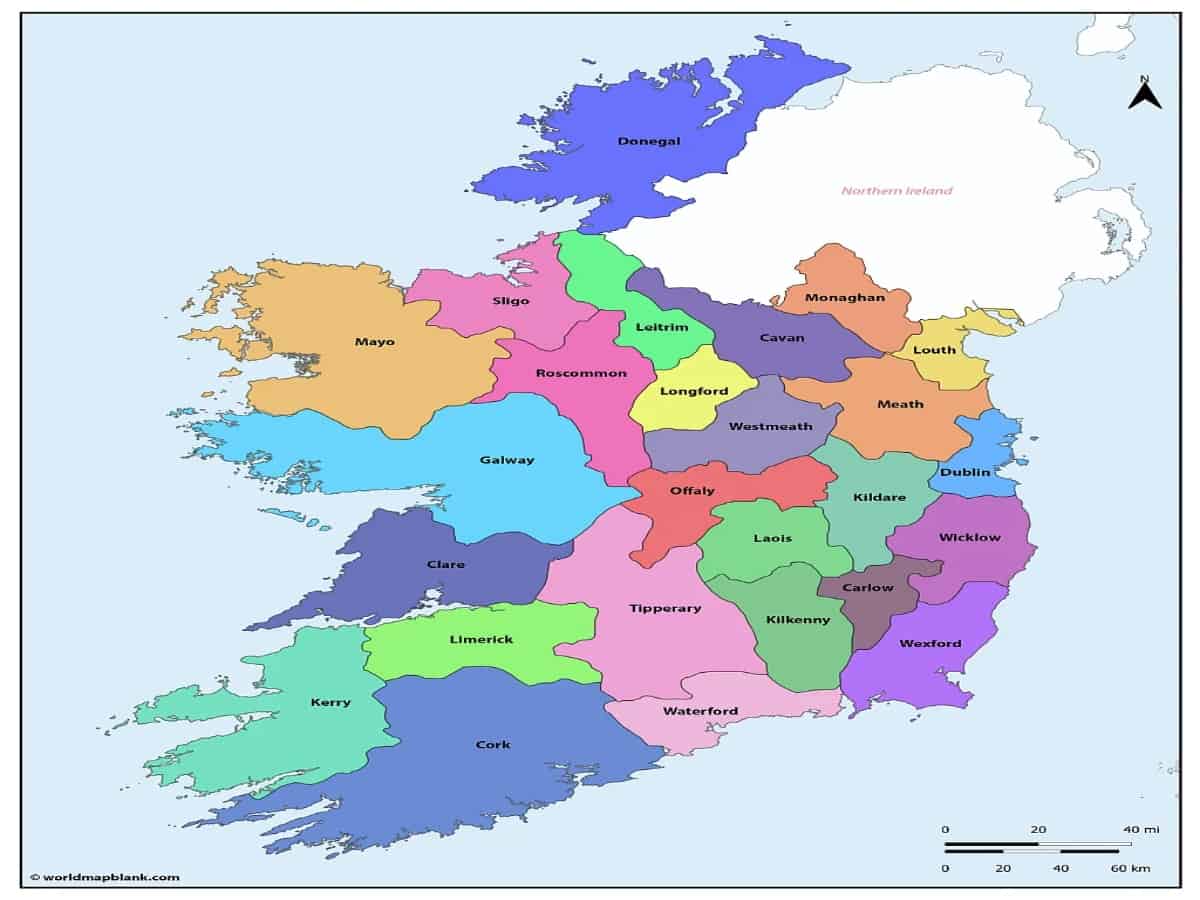
Final Thoughts
This was a ton of information thrown at you and we know that can be overwhelming, but if you plan a trip to Ireland in the future, we promise these driving tips will help make that time the best it can be. Keep this travel guide close by during your Ireland road trip, you’ll be glad you did.
Frequently Asked Questions
A road trip in Ireland can be rather intimidating with winding and narrow roads, as well as driving on the left side of the road instead of the right, but a road trip is definitely worth it. The sights you’ll see and experiences you have will make for a lifetime of memories.
We went during the month of June, which is when we recommend traveling to Ireland. This is at the start of the peak season so crowds are still on the small side. Anytime between the months of April through September would work, as the weather is usually milder through this period.
Ireland is quite small, so driving around it can be accomplished in one day. However, we recommend at least a week, if not two, to explore the many sights and attractions without having to rush too much.
What you should read next
Travel Resources For Your Next Trip
If you’re in the process of planning your trip and putting together your itinerary, these are genuinely the best resources that the Going Awesome Places team stands by 100%.
Credit cards: Don’t get burned by hidden fees on top of terrible exchange rates. When we travel now, we use the Wise Card. Simply load it with the currency you need before you go and use it as a regular VISA or their digital wallet card. Use their free app to track how much you have and top up when you need to.
Flights: Of all the booking search engines, Skyscanner is the most helpful and easy to use thanks to their Everywhere feature. Kayak is also another that’s we will often check as well.
Car Rental: If you’re looking to save money, these car rental coupon codes will be a true game-changer. Otherwise, DiscoverCars and RentalCars are great places to start.
Airport Parking: You’ll need a spot to leave your car at the airport so why not book a spot at a discount. Use code AWESOME7 to get at least $5 off at Airport Parking Reservations or Park Sleep Fly packages.
Data: We’ve been a huge fan of wifi hotspot devices like PokeFi because their rates are so good and you can use it globally but recently, we’ve really loved using eSIMs. The best one is Airalo. Save money by getting region-specific eSIMs and use referral code WILLIA9500 to get $3 USD credit on your first purchase. Ubigi is another one that we’ve had success with where they uniquely offer 5G coverage. Use code AWESOME10 to save 10% on your first order.
Hotels: Our go-to is Booking.com because they have the best inventory of properties including hotels and B&Bs plus they have their Genius tier discounts. The exception is Asia where Agoda always has the best prices. TripAdvisor is also useful for reviews and bookings.
Vacation Rentals: Your first instinct will be to check Airbnb but we always recommend checking VRBO as well if you’re looking for a vacation rental.
Tours: When planning our trips, we always check both Viator and GetYourGuide to at least see what’s out there in the destination that we’re going to. They often have different offerings and prices so check both.
Travel Insurance: Learn how to buy the best travel insurance for you. This isn’t something you want to travel without.
- Insured Nomads – Popular insurance provider for frequent travelers and comes with great coverage and special perks.
- RATESDOTCA – Search engine Canadians looking for the cheapest insurance including multi-trip annual policies.
- SafetyWing – A perfect fit for long-term nomads.
- Medjet – Global air medical transportation.
- InsureMyTrip – Best for seniors, families, and those with pre-existing conditions.
If you need more help planning your trip, make sure to check out our Travel Toolbox where we highlight all of the gear, resources, and tools we use when traveling.






